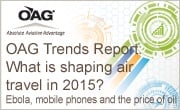As 2014 draws to a close we look into the new year and use our extensive database to predict what will be big news for the aviation industry in 2015…
*(Click here to see how these trends have progressed 18 months on in 2016)*
1. African aviation – More good news than bad
While Ebola put a spotlight on West Africa in 2014, it wasn’t the only story in African aviation. Growth slowed in 2014 and international departing seat volumes grew by 1.4% to 87 million, well below the 5.9% growth experienced in 2013. Meanwhile, domestic seat capacity in African countries saw the reverse trend. Growth in 2014 was 4.4%, significantly better than the 5.1% decline in 2013, and takes total domestic capacity to 49 million seats per annum.
In October 2014 IATA released its first 20 year passenger forecast. The forecast anticipates that African air passenger numbers will grow at an average annual rate of 4.7%, faster than the global average of 4.1%. By 2034 there will be an extra 177 million air passengers travelling to and from African airports taking the total market size to 294 million passengers. Furthermore, by 2034 eight of the ten fastest growing markets globally, albeit that some are relatively small in terms of absolute volumes, will be in Africa, and these include Central African Republic, Madagascar, Tanzania and Burundi.
2. South East Asia and the prized Chinese tourist
The largest market for travel to and from China by far is South Korea and the number of passengers flying between China and South Korea grew by 39% in the year to September 2014, reaching a high of almost three quarters of a million passengers per month.
While many of the largest markets for travel to and from China are within North East Asia many of the high growth markets are further afield. Traffic to and from Africa and Latin America may be small in volumes, at least to some countries, but many of the markets experiencing more than 50% growth in traffic between September 2013 and September 2014 are in these regions. These are journeys which are more likely to require a connection and so in 2015 we should expect to see the global airport hubs compete more fiercely for their share of this traffic. While the Chinese economy may not grow quite so fast in 2015, the growth in Chinese outbound travel is here to stay.
3. Mobile phones - Channelling aspirations
Mobiles and tablets are changing and expanding the distribution of air services; in the US in 2015 Americans will book USD 39.5 billion worth of reservations on their mobile devices, accounting for 12% of all travel sales, according to PhoCusWright. More than half (53%) of Chinese international travellers are now booking their hotel accommodation on the web via mobile apps. They may also be growing the market itself as travellers use social media to exchange views on destinations and show off where they’ve been to by sharing photos. Today’s travellers want more control over every aspect of their journey and mobile devices give them that, so in 2015 expect to see more airlines engaging with their customer base via mobile technology.
4. The price of oil
Through the second half of 2014 the jet fuel price dropped significantly. As of mid-November IATA was reporting the price as being down by 20% compared to a year earlier and that the impact on the fuel bill for the global airline industry in 2014 would be a saving of USD7 billion. The only shadow on the horizon is the possibility that the lower oil prices reflect weaker demand in the global economy and, if that were so, air travel demand may be set to weaken.
5. Arrival of the A350 XWB
Qatar Airways was the launch customer for the A350, with the new aircraft arriving just before Christmas. What does the arrival of this newest fleet member mean for the market in 2015?
 All data and analysis is taken from the OAG Trends Report: What is shaping air travel in 2015? Click below to download the full report.
All data and analysis is taken from the OAG Trends Report: What is shaping air travel in 2015? Click below to download the full report.
*(Click here to see how these trends have progressed 18 months on in 2016)*



